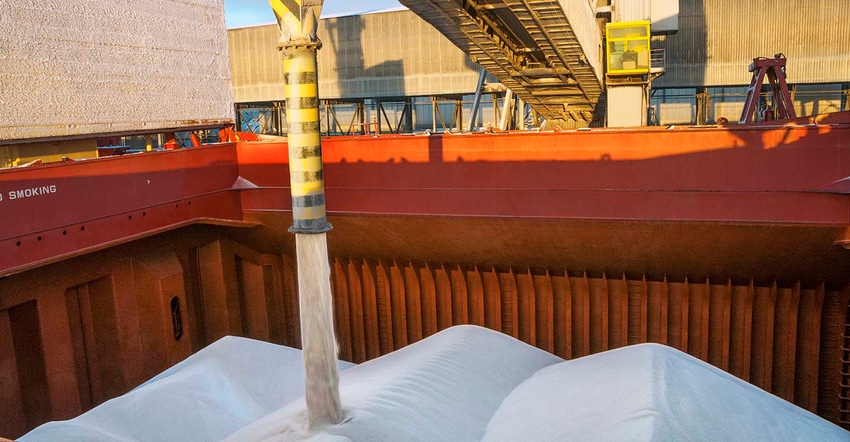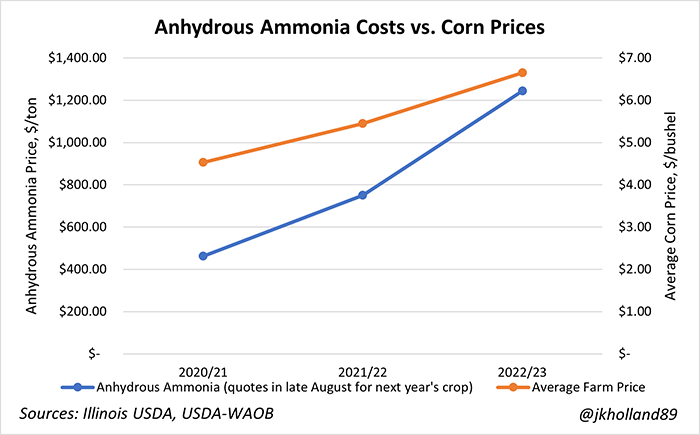
The big challenge in 2023 crop budgets? No surprise – it’s fertilizer, or 36% of variable corn costs, according to USDA. From October 2020 to Oct. 2021 anhydrous prices nearly doubled and will remain stubbornly high for the near term. According to a June 2022 Iowa State study, fertilizer prices are two to four times higher now than in 2020.
But, why?
It’s easy to point a finger at the Russia-Ukraine conflict as the source of this pain, but unchecked consolidation that reshaped the fertilizer industry into an oligopoly began long before the guns began blazing last February. Half of UAN produced in the United States comes from CF Industries. Mosaic produces some 75% of U.S. phosphorus and last year successfully got the Department of Commerce to place countervailing duties on two of its major competitors, Russia and OCP Morocco. Meanwhile, four companies – CF Industries, Nutrien, Koch and Yara-USA – make and sell 75% of nitrogen-based fertilizers in this country.
Industry consolidation began soon after ag’s golden era began to wane some eight years ago. Fertilizer companies saw crop prices drop and began to trim costs; to survive, they merged and grew. This happened right in front of our eyes. The antitrust folks in Washington, D.C. did not weigh in. We see unprecedented concentration in not only fertilizer but also soybean processing, beef processing and pork processing.
“Don’t expect DOJ (Department of Justice) to come break up the fertilizer companies,” says Josh Linville, vice president-fertilizer for StoneX. “There’s a lot of other industries they will look at before they get around to fertilizer concentration.”
It doesn’t hurt if you can eliminate your competitors. In 2020 DAP (Diammonium Phosphate) had dropped to $250 a ton before Mosaic called for the countervailing duty on Russia and Morocco. Today the DAP retail price is nearly triple that. But that higher price also reflects an increasing difficulty Mosaic faces in extracting phosphate rock from the ground. So a ton of DAP that cost $750 per ton retail probably costs the company $575 per ton to produce, says Linville.
“It’s not gouging,” he points out. “They are one of the highest cost phosphate producers in the world. They’re going to do everything they can to survive.”
A world of haves and have-nots
Fertilizer is costly because supplies tightened. It started in 2021 when China, the world’s largest maker and user of anhydrous, stopped exporting phosphate over domestic food worries. No one is sure if or when it will return to the market. While the U.S. did not buy much phosphate from China, the country did account for 30% of world phosphate trade. Other countries began hoarding in response to security worries and higher food prices.
But the biggest concern of all is Russia. According to FAO, last year the Russian Federation ranked as the world’s top exporter of nitrogen fertilizers, the second leading supplier of potassium fertilizers and the third largest exporter of phosphorous fertilizers. By shutting off natural gas to Europe, it crippled one of the world’s leading anhydrous ammonia suppliers. Europe’s plants are now closed until further notice, turning an entire region from a supplier into a buyer that every other farmer must compete against.
“The result has been global N values skyrocketing as it comes to terms with losing an entire producing region,” says Linville.

At least U.S. farmers don’t have the same worries their European counterparts have.
“We are actually somewhat insulated from the global tightness in fertilizer,” says Jacqueline Holland, Farm Futures grain market analyst. “We can produce most of our own fertilizer.”
Wouldn’t expanding fertilizer production be the answer to tight supplies? Of course.
But with the Black Sea conflict and overarching fears of a global recession, companies shy away from big expansion projects, because it takes too long to see returns.
“That’s what we’re seeing in Wall Street right now - shareholders opt for short term plans that guarantee a good dividend the next quarter,” says Holland. “If you start talking about investing billions in a plant that won’t earn returns for a decade, shareholders don’t want that, especially if farmers are willing to pay the higher prices – which they are.”
Win or lose in Ukraine, Russia is trying to re-structure the world order through food supply. It is weaponizing fertilizer, to coin a phrase Newsweek used in a summer opinion piece. It is taking care of the fertilizer needs of its friends in China and India, and that is leading to political gains.
Countries closer to home, like Mexico and Brazil, depend on fertilizer imports. There's no doubt Russia will try to make political inroads as it grows export sales in those countries. Several countries in Latin America, Eastern Europe and Central Asia rely on Russia for over 30% of their fertilizer needs. The same is true in Africa: Ghana, for example, buys half of its fertilizer from Russia. Iran, no friend to the U.S., is also sending fertilizer to Brazil.
Where does it leave us? Vulnerable.
“Not a lot of friends produce things we need, other than Canada and its potash,” notes Linville. The Russian economy is suffering but not as much as you might expect, because Brazil and India have no problem buying their fertilizer.
About the Author(s)
You May Also Like






